While guitars and synthesizers appear to have not much in common as musical instruments, there are a few parallels that can be traced between them that are partly responsible for the major popularity of each.
First of all, the design and sonic palette of both instruments are extremely expandable. Guitars can come in various shapes, have an arbitrary number of string arrangements, and the instrument can be re-tuned to accommodate for various styles and playing techniques. Synthesizers...well, there are truly no limits to how they may look, sound, or be played.
Secondly, while both guitars and synthesizers can be used for very complex forms of musical expression, they also are very approachable by novices. Geometrically repetitive chord shapes on the guitar enable users to play hundreds of songs while only learning a few patterns. Synthesizers allow for creation of dense and complex sounds, or even whole musical phrases and sections by means of automation and sequencing, thus removing the barrier of developing physical agility, which is an essential step in training on most any other musical instrument.
Although both instruments are already quite powerful in their own right, there are multiple ways in which they can be nicely integrated with each other. As synthesizers (and modular synths in particular) grow in popularity, a substantial number of people are now approaching them from not a keyboard background, but from being trained in other instruments—including guitars. Thus, I would like to briefly explore a few common and not-so-common ways to couple electric guitars and Eurorack modular synthesizers. And for all you non-guitarists—everything described can also be easily applied to any other acoustic or electric instrument, given that it is sufficiently amplified.
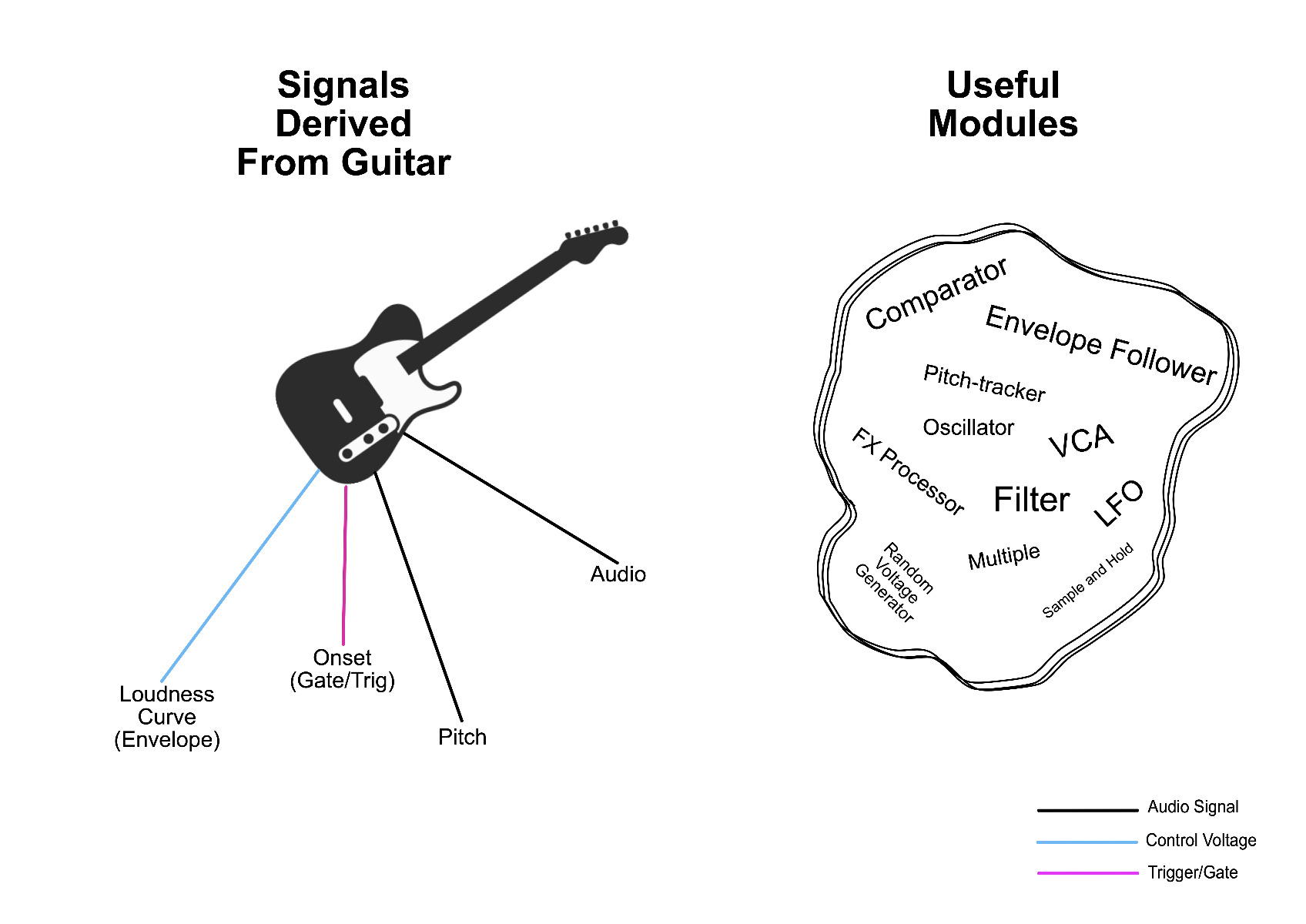
Modes of Interaction
There are two primary ways of interconnecting guitars and synthesizers. In one scenario, we can use a synthesizer's processing modules (including filters and other effects) to alter the sound of the instrument. This is very similar to using a pedal board, but with much more flexibility. The second option for integration involves using the guitar (or any other instrument) as a controller for synthesizer. This is accomplished using specialized modules that extract aspects of the performance, like intensity of playing, pitch, note onset, and transform them into CV/Gate signals.
Of course, you can combine both modes to facilitate an even more interwoven relationship between the two instruments. Later in this article we will look at a couple of examples, but before we move any further, we need to establish the base point for making the interaction between guitars and synthesizers possible: I am talking about amplification.
You may already know that Eurorack signals are much hotter than line and instrument level signals. Thus we need to use a preamp module that will boost the level of our instrument enough to be usable with the synth. There are plenty to choose from ranging from very straightforward options like the Intellijel Designs Audio Interface II, Joranalogue Receive 2, or the Input in the Make Noise CV Bus Case, all the way to more tricked-out options such as XAOC Devices Sewastopol II and Boredbrain Injectr. Once the signal is sufficiently amplified, the world is your oyster.
Routing
Those immersed in the world of guitar pedals will know that the process of changing the routing of pedals is notoriously cumbersome. Pedals are usually connected in series, one after another, and the decision of the order in which they are connected has to be carefully considered...as once everything is connected, it is to stay this way for a while. In traditional setups, changing the routing on the fly is completely out of the question, however this can be overcome with matrix mixers and clever devices like Boredbrain Music's Patchulator 8000.
In the world of modular synthesis, though, patching and rerouting signals is a much more dynamic process, and can even be utilized as part of the performance. There are simple utilities like signal splitters, and all kinds of mixers that make the process seamless, and even open up new possibilities. For example, parallel processing of the guitar signal through effects is an incredibly painless endeavor using a complement of basic modules such as multiples and mixers. Moreover, somes modules allow you to explore more esoteric signal mixing/routing opportunities: Intellijel Designs Planar 2, for instance, allows you to explore vector mixing, where you can use a joystick controller to dynamically route your signal to up to four different effects processors or route up to four input signals to a single effect module...or to continuously crossfade between several different effects running in parallel.
This flexibility of routing in modular synths also presents a great framework for exploring feedback...but we'll save this subject for some other time.
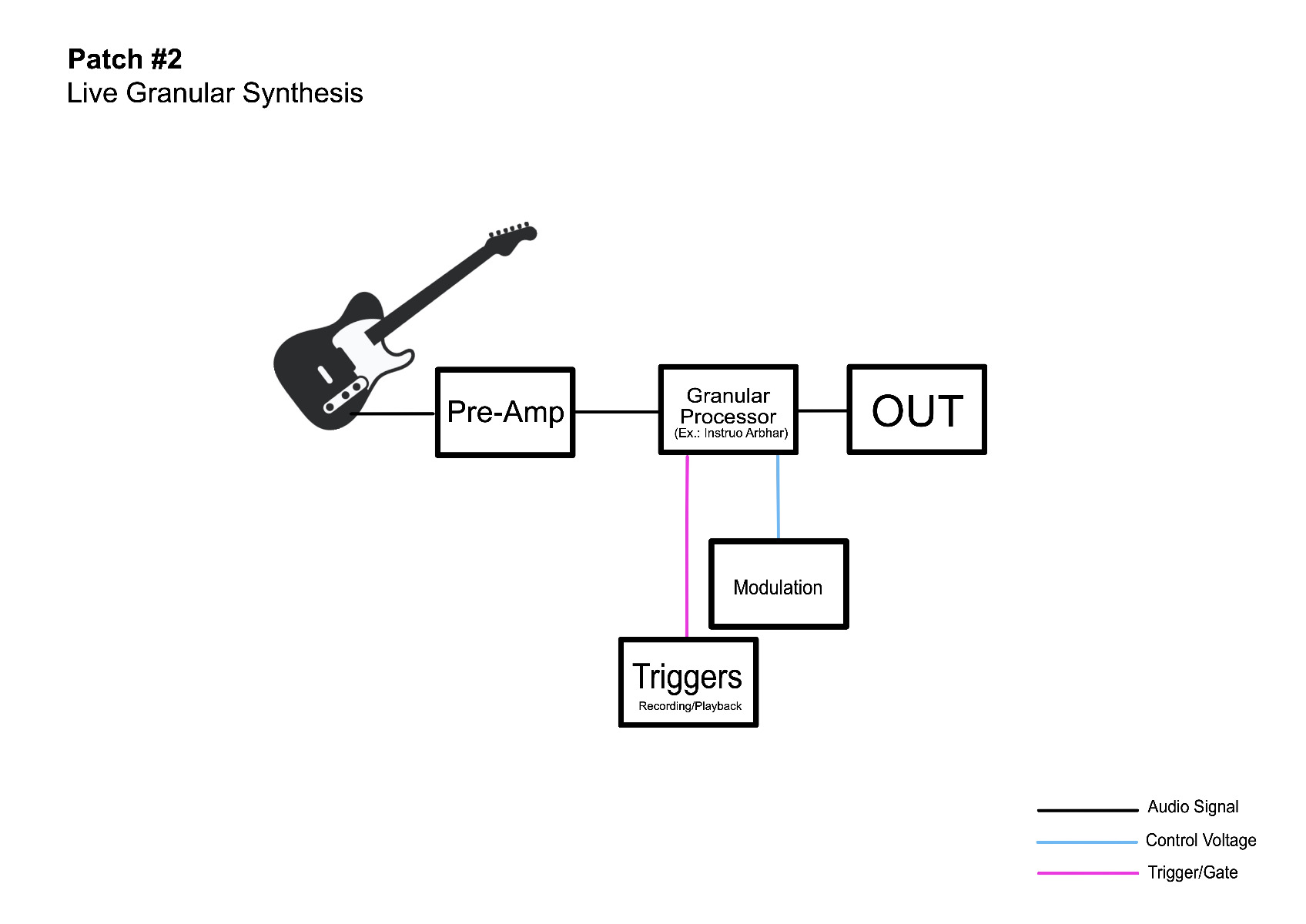
Processing
Processing the audio signal from an instrument seems like a safe place to start, as many of us in one way or another are already familiar with the concept. You send the output of your instrument into a sound processing unit (pedal/module), play a note, and voila!, the output signal is radically altered..
Among the great variety of Eurorack modules, you can easily find every sort of familiar effect, including delays, reverbs, distortions, overdrives, phasers, and so on. Additionally, the effects tend to be more customizable, provided that their parameters are voltage-controllable. So for example, certain sounds you can achieve with a reverb like Make Noise Erbe-Verb would be pretty much impossible to replicate with any reverb in the pedal world. Using granular synthesis techniques with modules like Make Noise Morphagene, QuBit Electronix Nebulae 2, and Instruo Arbhar, you can zoom in on microscopic details of the sound your guitar makes in real time. Effect-oriented synthesizer modules are often a bit more experimental and embrace open-ended means of interaction—making them generally quite different to use than their pedal counterparts, and often allowing considerably deeper exploration.
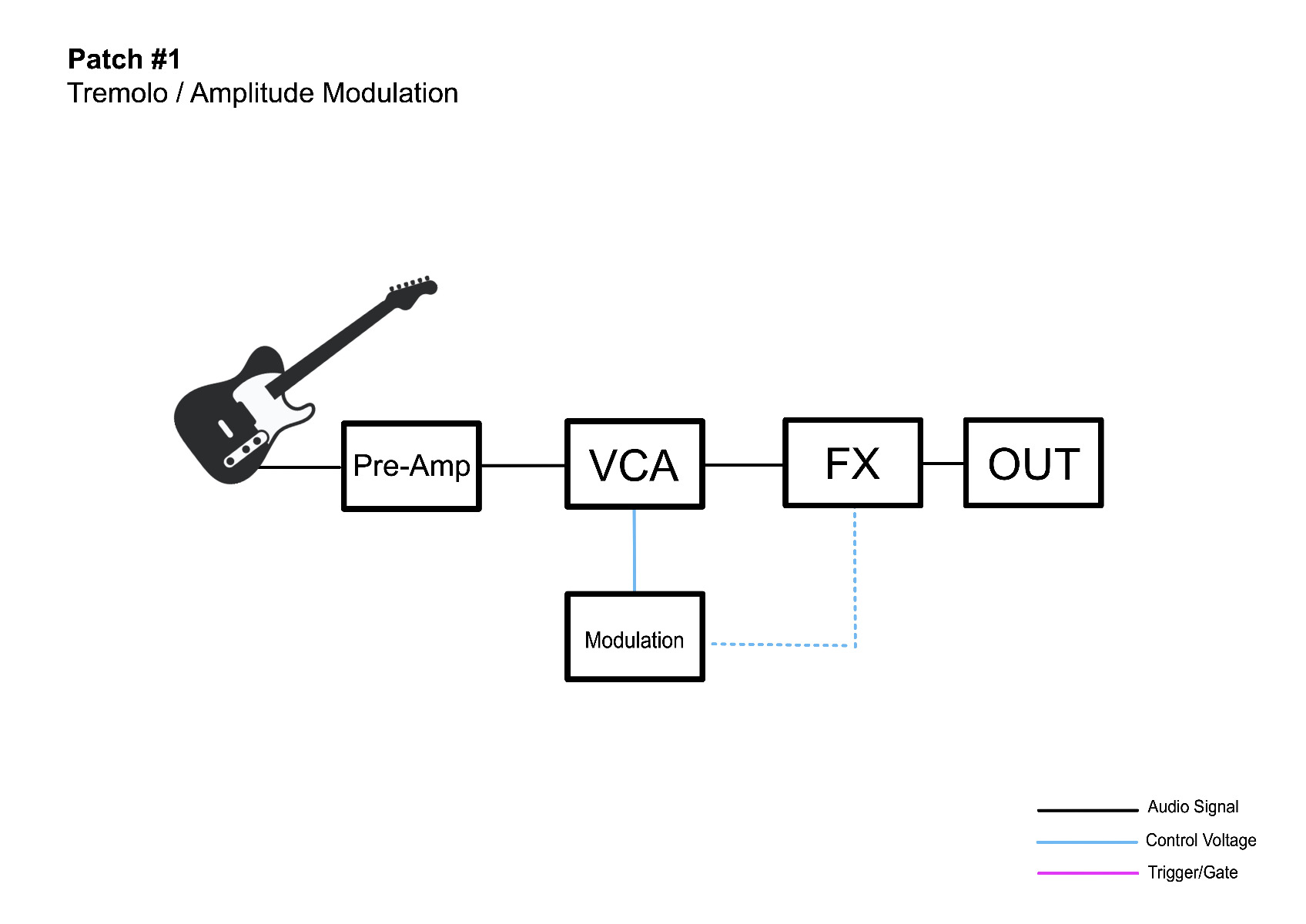
What's even better, you are free to create some (or any, depending on the size of your system) effects entirely from scratch using rudimentary modules. For example, sending your guitar into a VCA, and then modulating its level with an LFO yields a tremolo effect. However, because it is entirely up to you what kind of waveform you use for the modulation, what frequency it is set to, and how you control the frequency of your LFO, you are able to get an insane amount of control over the effect. Set the modulation frequency to an audio rate, and you've got yourself an AM (amplitude modulation) effect. Replace a regular VCA with a bipolar one, and suddenly you have a Ring Mod.
Sending your guitar through a filter is yet another way to create interesting sonic effects, and Eurorack is abundant with all sorts of filter flavors. You'll find modules that are inspired by classics like the Moog's buttery Transistor Ladder Filter (AJH Synth MiniMod Transistor Ladder VCF), and the wild and screamy Korg MS-20-style filter (Intellijel Designs Morgasmatron), as well as more novel and unconventional designs like Make Noise QPAS, Industrial Music Electronics Bionic Lester, Xaoc Devices Belgrad, and Rossum Morpheus. With such a variety, there is no visible end to sonic exploration, and you can easily recreate things like the Wah Wah pedal by adding a Doepfer A-177-2 Foot Controller module and an expression pedal.
I also enjoy creating weird and gnarly tones by modulating the frequency and other parameters of the filter with audio rate signals, as well as injecting some feedback into the mix by routing one of filter's outputs back in to one of its inputs (stackable cables and attenuators may be useful here). You can even use the guitar signal itself to modulate the filter frequency, leading to a particularly gnarly, ear-bending form of distortion.
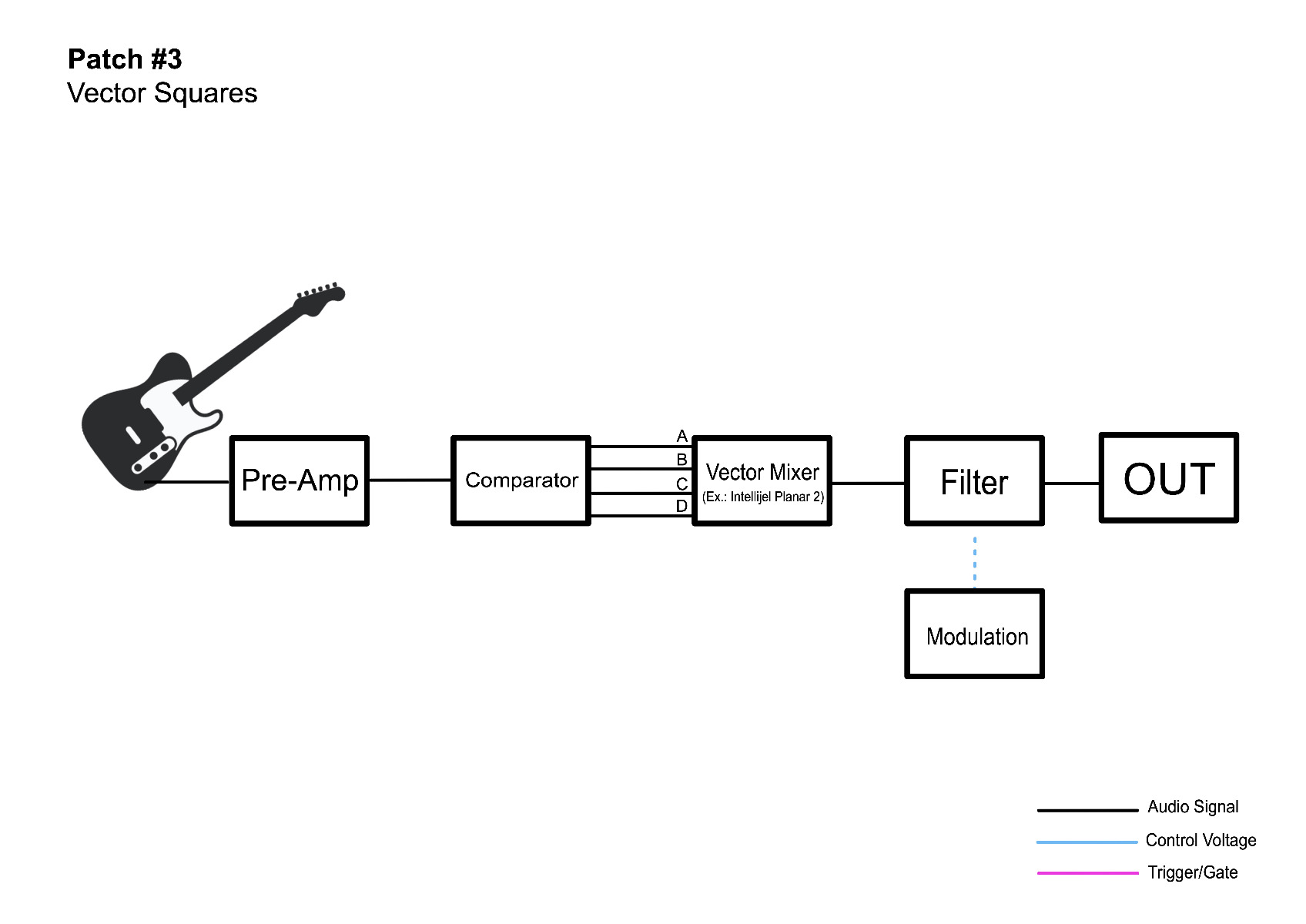
One other useful type of module for guitar + synth integration is a comparator. Joranalogue Compare 2, Random*Source Serge NCOM, and at certain settings Make Noise Maths are all great examples. A comparator is one of those modules that can be useful for both control and audio processing, depending on the incoming signal. Essentially, it compares two voltages, and outputs a gate when the first voltage is higher than the second one. Note that the second voltage doesn't have to be another incoming signal, but can simply be a reference voltage set by the knob.
Using low frequency material with comparators produces signals useful for clocking, and event triggering—however, when audio rate signals like that of a guitar enter a comparator circuit, the output is a pure square wave that matches the frequency of the input signal. And just like that, you convert your guitar into a synthesizer. Using various types of processing, you can modify that squarewave further. A particularly nice complement to a comparator would be a frequency divider, such as Doepfer's A-163, which will allow you to drop the frequency of that square wave down an octave or a few. Add a filter to this mix and you've turned your guitar into a synth bass.
It is also useful to know that playing chords through a comparator will be reminiscent of a fuzz/distortion sound, but once you add a frequency divider the chords may no longer usable, as they are too "muddy" of a signal to be analyzed, thus you have to resort to single-line monophonic playing.
Control
Paired with the right set of tools, guitar can provide much more than just an audio signal. Onset detectors can convert plucking of a note into a gate or a trigger, envelope followers turn the intensity and loudness of the performance into modulation curves, and pitch-trackers are able analyze the notes you play and output 1V/Oct-ready control voltage signals.
Often you will encounter modules that combine several functions under a single panel. For instance, the combination of an envelope follower and an onset detector is pretty common. Some examples include Mutable Instruments Ears, Make Noise Maths and Function, Doepfer A-119, Steady State Fate Detect-Rx. The B3 algorithm on Expert Sleepers' Disting Mk4 combines pitch-tracker and an envelope follower.
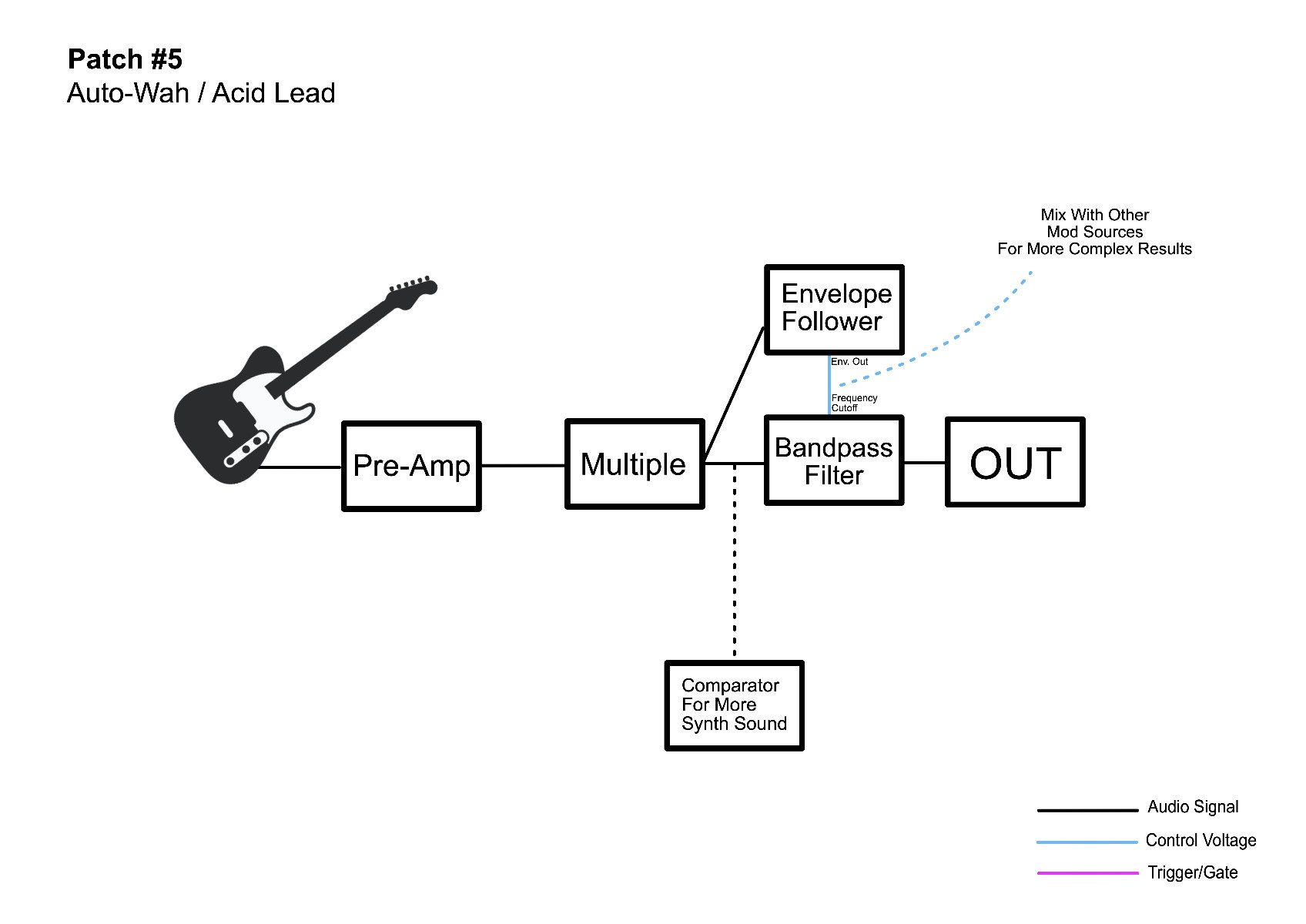
A simple, yet effective patch using the envelope follower circuit is an Auto Wah effect commonly used in 70s funk and disco music. Duplicate the amplified output of your guitar using a multiple, and run one copy of it into a filter module, and another one into an envelope follower. Send the CV output of the envelope follower into the cutoff frequency of the filter. Adjust parameters to taste, and you are set—now the harder you hit the string, the more the filter opens. Add a comparator and a frequency divider between the guitar output and the filter, and you are ready to play some acid basslines and psytrance leads.
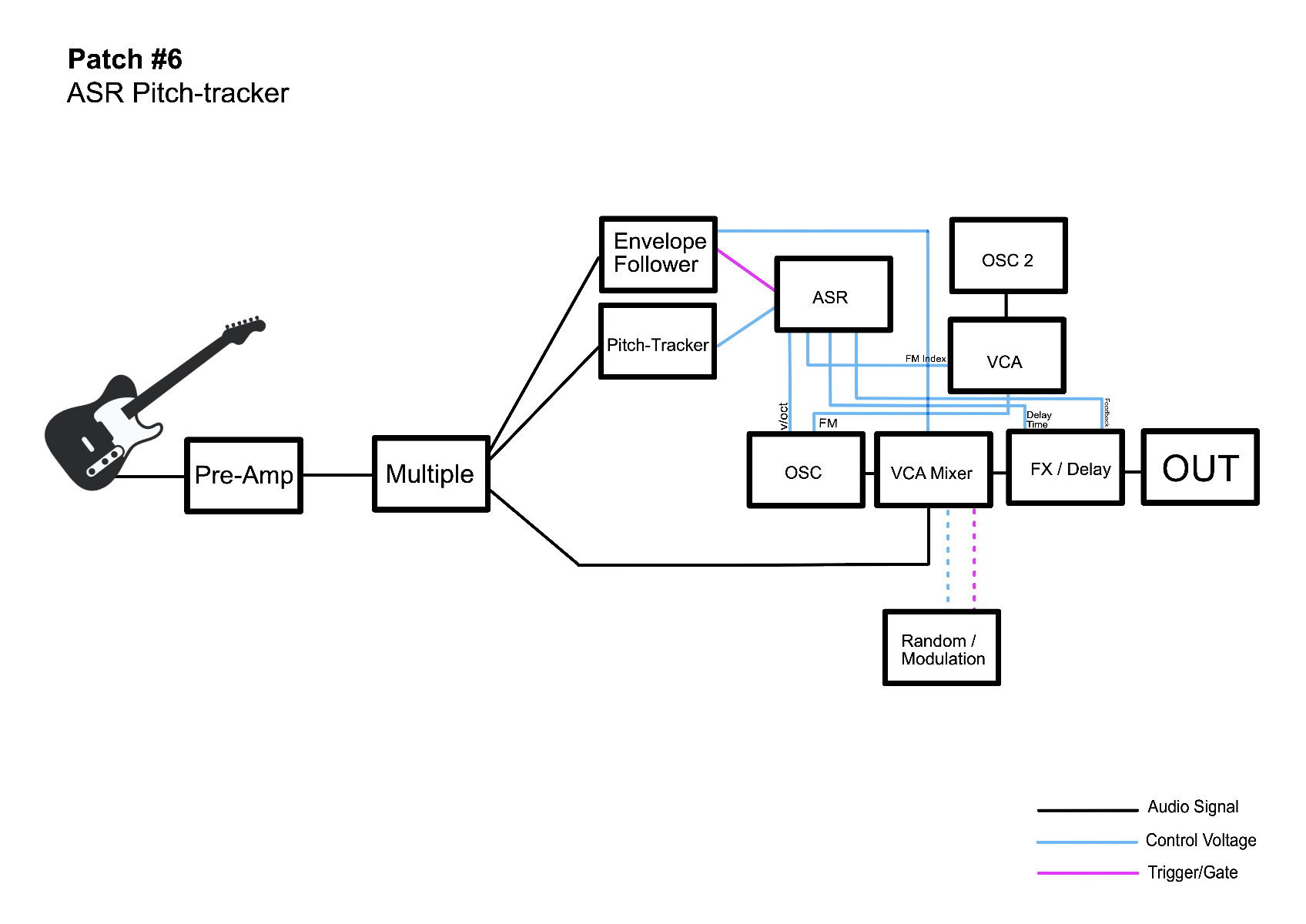
While envelope followers are fairly common, pitch trackers are presently hard to come by, and the only option we've found among our stock is precisely that algorithm in the Disting module. Analogue Systems's RS-35 is another solid option, Second Sound UniSyn has a dedicated pitch CV output, and of course if you own a Korg MS-20 (or MS-20 Mini) the External Signal Processor section is endowed with a pitch-following circuit. Regardless of what you end up using, there are a couple of things worth considering when working with pitch-trackers. Firstly, they expect a monophonic signal, so don't try to play chords...or do, and just don't expect the module to provide any obviously meaningful output. Secondly, the cleaner and simpler the incoming waveform is, the more accurate the output will be...thus it may help trimming down the edges of your signal with a clean bandpass filter. Lastly, for the same reason, the playing technique you use will affect the results, so palm muting the strings and avoiding any string rattling will be helpful too. Also, keep the spirit of experimentation in mind, and explore the pitch-follower in conjunction with other CV-processing modules. I've had some interesting results by running the output of a pitch-tracker into the input of an analog shift register triggered by the gate coming from an onset detector. As a result, you get multiple spread out control voltage outputs derived from the notes you chose on the instrument that can be used to control various selected synth parameters.
If you are concerned about hitting "bad notes," you can also route the output of the pitch-follower through a quantizer module set to a preferred scale—making things a little more fool-proof overall.
The practice of instrument controlled synthesizers is not new, and there have been many attempts to integrate the two both by artists and manufacturers for decades now. Some may remember the guitar-synth sound of Pat Metheny using GR-300 and Synclavier, but the potential applications spread way beyond the world of jazz-fusion.
Keith Fullerton Whitman's excellent Playthroughs is an ode to imperfections and inaccuracies in pitch-following. Sarah Belle Reid's eloquent debut Underneath and Sonder is composed and performed using an interactive system based on a trumpet augmented with custom MIGSI hardware and a software modular synthesizer. Saying this, it should still be clear that there is plenty of untapped territory to explore. So feel free to experiment, and get ready for pleasantly surprising results.








